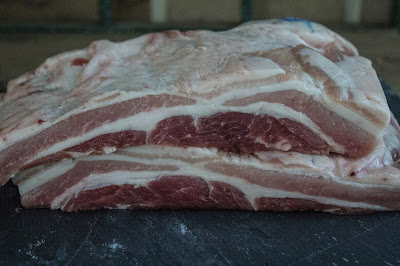Preserving Pork Belly as Rillons
Autumn is a classic time for preserving: apples are turned to sauce, late flushes of tomatoes are canned, herbs are strung and dried. Moving from the garden to the pasture, fall also offers a number of ways to preserve meats during the cooler months. Preserving meat might seem intimidating, but it's easy to get started with a simple and delicious recipe like rillons.
A French bistro classic, rillons are cubes of fresh pork belly cooked for hours in fat until they are unctuous and tender. Much like duck confit, the cooked pork belly can be stored under the cooking fat for months in the refrigerator. Then the rillons can be warmed in a pan and served with a salad, eggs, or as a hearty hors d'oeuvre with crusty bread.
To start, slice the belly into two inch cubes. Then season the meat with salt, tossing the cubes in the salt to coat the outside of the meat. A mix of rosemary, thyme, black pepper, and bay added to the salt rub adds another level of flavor to the meat.
Refrigerate the meat for 12 hours or overnight. This will allow the salt to pull the water from the fresh pork belly, producing a layer of brine on the bottom of the container. Pour off the brine and rinse any excess salt and herbs from the pork belly.
Pat the pork belly dry, then heat up a skillet and a sauce pot. Grease the skillet with a spoonful of lard. For the sauce pot, add a cup of lard (or two if you're making a lot of pork rillons). Brown the cubes of pork in the skillet in a few batches, adding the browned off pieces to the pot of warm lard. By browning the pork belly first, the rillons will take on a rich, savory flavor that really pays off in the final dish.
Once all of the pork is seared, brown a few cloves of garlic in the leftover fat, then add a cup of dry white wine (like Noilly Prat) to deglaze the bottom of the skillet. Scrape up all the drippings from the sauce pan and pour into the pot of lard.
There should be enough lard to cover the pork belly, but don't worry if a few pieces are sticking out on top. As the belly cooks, it will render out its own lard, covering the final peaks of the pork. Gently simmer the pork for about 3-4 hours, stirring from time to time. By cooking the pork low and slow, it will cook off the water in the meat and help preserve the pork.
While the rillons can be enjoyed right away (be sure to try at least one piece hot from the pot!), they can be stored in the fridge by packing them in clean mason jars or crocks and covering them with the cooking lard. To prep the jars, wash them in hot soapy water, then warm the jars in a 300 F oven for 15 minutes. Put the pork belly into a warmed crock and pour over enough fat to cover them by 1/2 inch.
When it's time to serve, remove the rillons from the fat and crisp them in a skillet or on a baking sheet in a oven. Rillons are wonderful as a charcuterie component to a cheese plate, on top of a salad, or served simply on bread with good grainy mustard.
Recipe at a Glance:
1 lb North Woods Ranch Pork Belly
1 tbsp kosher salt
1 fresh bay leaf, cut into strips
1 sprig thyme, minced
1 sprig rosemary minced
1 cup dry white wine
Several turns of black pepper
1-2 cups lard, plus 2 tbsp
4 garlic cloves, smashed
- Cut the pork belly into 2" cubes. Toss with salt, pepper, and herbs. Put into a nonreactive (ceramic or glass) container and cover with a lid or plastic wrap. Refrigerate overnight.
- The next day rinse off the pork belly cubes and pat dry. Heat a skillet with 2 tablespoons of lard, plus begin melting the rest of the lard in a sauce pot.
- Sear the pork belly on 2-4 sides (depending on the shape) until brown and crispy. Put the browned pork belly in the pot of melted lard. Add the garlic to the skillet and brown for 30 seconds. Pour in the wine to deglaze the skillet, scraping up all the browned bits on the bottom of the pan. Pour the pan drippings into the pot of lard.
- Simmer the pork belly for 3-4 hours at a bare simmer. If using within a few days, store the rillons in the refrigerator, or store for a few months in the fridge following the method described above.
 |
| North Woods Ranch Fresh Pork Belly |
To start, slice the belly into two inch cubes. Then season the meat with salt, tossing the cubes in the salt to coat the outside of the meat. A mix of rosemary, thyme, black pepper, and bay added to the salt rub adds another level of flavor to the meat.
Refrigerate the meat for 12 hours or overnight. This will allow the salt to pull the water from the fresh pork belly, producing a layer of brine on the bottom of the container. Pour off the brine and rinse any excess salt and herbs from the pork belly.
 |
| Note the pooled brine that accumulates after 12 hours. |
Once all of the pork is seared, brown a few cloves of garlic in the leftover fat, then add a cup of dry white wine (like Noilly Prat) to deglaze the bottom of the skillet. Scrape up all the drippings from the sauce pan and pour into the pot of lard.
There should be enough lard to cover the pork belly, but don't worry if a few pieces are sticking out on top. As the belly cooks, it will render out its own lard, covering the final peaks of the pork. Gently simmer the pork for about 3-4 hours, stirring from time to time. By cooking the pork low and slow, it will cook off the water in the meat and help preserve the pork.
While the rillons can be enjoyed right away (be sure to try at least one piece hot from the pot!), they can be stored in the fridge by packing them in clean mason jars or crocks and covering them with the cooking lard. To prep the jars, wash them in hot soapy water, then warm the jars in a 300 F oven for 15 minutes. Put the pork belly into a warmed crock and pour over enough fat to cover them by 1/2 inch.
When it's time to serve, remove the rillons from the fat and crisp them in a skillet or on a baking sheet in a oven. Rillons are wonderful as a charcuterie component to a cheese plate, on top of a salad, or served simply on bread with good grainy mustard.
Recipe at a Glance:
1 lb North Woods Ranch Pork Belly
1 tbsp kosher salt
1 fresh bay leaf, cut into strips
1 sprig thyme, minced
1 sprig rosemary minced
1 cup dry white wine
Several turns of black pepper
1-2 cups lard, plus 2 tbsp
4 garlic cloves, smashed
- Cut the pork belly into 2" cubes. Toss with salt, pepper, and herbs. Put into a nonreactive (ceramic or glass) container and cover with a lid or plastic wrap. Refrigerate overnight.
- The next day rinse off the pork belly cubes and pat dry. Heat a skillet with 2 tablespoons of lard, plus begin melting the rest of the lard in a sauce pot.
- Sear the pork belly on 2-4 sides (depending on the shape) until brown and crispy. Put the browned pork belly in the pot of melted lard. Add the garlic to the skillet and brown for 30 seconds. Pour in the wine to deglaze the skillet, scraping up all the browned bits on the bottom of the pan. Pour the pan drippings into the pot of lard.
- Simmer the pork belly for 3-4 hours at a bare simmer. If using within a few days, store the rillons in the refrigerator, or store for a few months in the fridge following the method described above.






Comments
Post a Comment